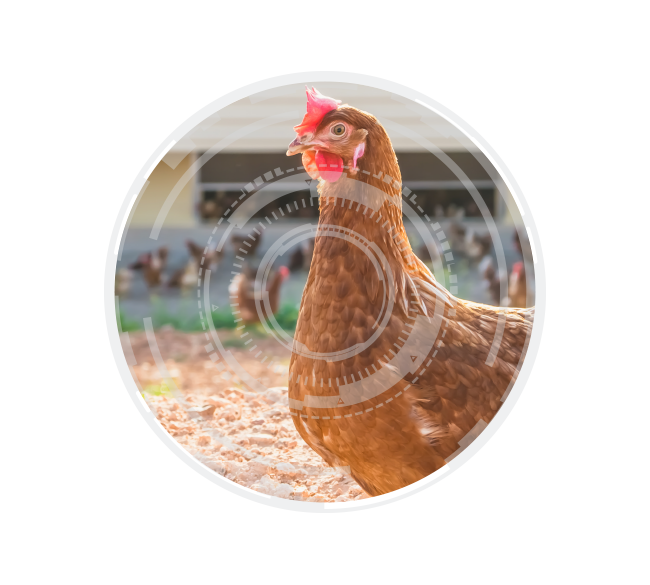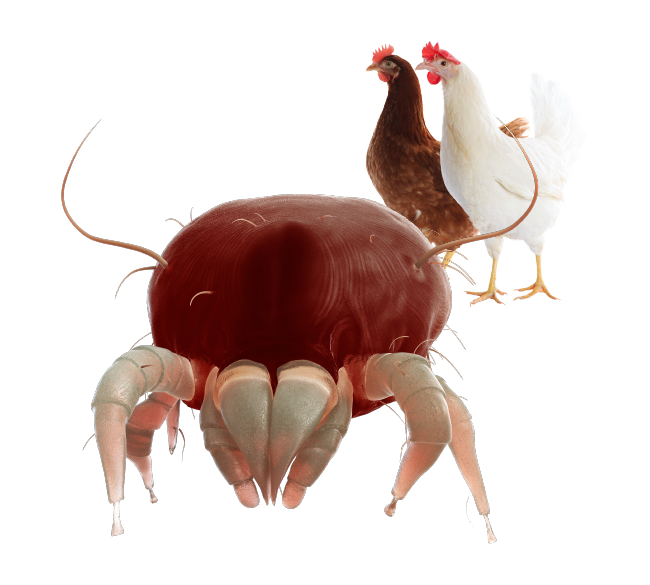Hungarian University of Agricultural and Life Sciences, Kaposvár Campus, 7400 Kaposvár Guba Sándor str. 40, Hungary

Professor Dr. Zsolt Szendrő is a senior scientist at the Hungarian University of Agriculture and Life Sciences Kaposvár Campus (formerly Kaposvár University). His research activity is related to small animal breeding, primarily to rabbit breeding.
He was elected as the vice-president of the World Rabbit Science Association three times, so he held this position for 12 years.
He was also elected as a member of the Hungarian Academy of Sciences. He published nearly 250 scientific papers, which resulted more than 4,000 independent citations.
ABSTRACT
Commercial rabbits are traditionally kept in cage systems. These systems are criticised by animal welfare organisations.
The main arguments are limited space to move, particularly when only small groups are housed in a cage, high stocking density, low cage height and perforated floor material.
The present study shows results of experiments of the authors research facilities and related publications. Increasing the total space to move using larger groups for growing and leads to serious behavioural problems, aggression, injuries, increased mortality and poor production and reproduction.
Based on preference tests and performance criteria, stocking density of 16 rabbits or 40 kg liveweight/m² are considered adequate from the behavioural and economic point of view.
Keeping rabbits on deep litter increases the risk of infectious diseases.
Deep litter prevents the dissipation of metabolic heat. Perforated floor material with sufficient perforation space allows heat dissipation, prevents soiling of the floor surface and the rabbit’s feet and thus, leads to better welfare.

INTRODUCTION
In Europe, rabbit production is a small sector of livestock production. The consumption of rabbit meat low as compared to pork, beef and poultry. Commercial rabbit production concentrated on a few countries, such as Russia, Ukraine, Italy, France and Spain.
Management, nutrition and disease prevention in breeding stocks and growing rabbits requires specialized knowledge and experience. Housing, behaviour and welfare are important areas of research. There is no welfare regulation of rabbit production in the EU. National regulations exist in Switzerland and Germany.
Since rabbits are traditionally kept in cages, animal welfare organizations and activists put significant pressure on supermarkets, consumers, politics, and eventually on the farmers not to produce or to sell rabbits meat produced under cage conditions.
Their knowledge of the housing and the particular needs of animals is limited and the expectations on appropriate housing and management of rabbits is often based on emotional impressions. Actions, such as «End of cage age» have been launched in several European countries.
The European Union aims at setting strict welfare standards for housing of farm animals. They should be based on scientific results on the needs of animals.
Researchers therefore have a great responsibility to assist governmental authorities in developing laws and regulations on appropriate rabbit keeping. In the following experimental results on the main welfare issues of growing rabbits, such as the effect of group size, stocking density and enrichment on performance and welfare criteria will be presented.
In most experiments, the productive and reproductive performances, mortality, aggressive behaviour and injuries were evaluated. The effects of group size and stocking density were most frequently examined. More recently, the environmental enrichment has also been a frequently studied area.

GROUP SIZE
The best production results were obtained with individually housed growing rabbits (Maertens and De Groote, 1984; Xiccato et al., 1999). Despite the good productive performance achieved in individually housing system, rabbits living in social isolation can display physiological symptoms of stress (Held et al., 1995; Chu et al., 2004), may be bored and consequently, show certain stereotype behaviour, such as biting or licking the cages (Podberscek et al., 1991).
Trocino et al. (2013) found that the rabbits in individual cages exhibited high fear level towards humans and new environment. Rabbits in bicellular cages (two rabbits/cage) were in less stressful condition compared to individual cages. Therefore, individual housing of growing rabbits is not recommended. It is prohibited in Europe for lacking social contact between the animals.
Compared to 2 rabbits/cage, feed intake of growing rabbits decreased in larger groups (Maertens and De Groote, 1984; Xiccato et al., 1999; Dal Bosco et al., 2002; Szendrő et al., 2009).
This is due to a higher level of social stress in groups, which has been shown even in European wild rabbits. The chronic stress results in weakening of the immune system and increased susceptibility to gastrointestinal diseases and poorer absorption of nutrients (Szendrő and Dalle Zotte, 2011).
Keeping rabbits in large groups also affects other production and slaughter traits. Figure 2 shows, based on several literature data, the weight gain of rabbits in response to increased group size compared to two rabbits per cage (Szendrő and Dalle Zotte, 2011).
This means that a week longer rearing time is required for rabbits to reach the same final body weight. At the same time, as Figure 2 shows that body weight gain in larger groups decrease in all but two studies compared to 2-rabbit cages.
Effect of group size (6-16 rabbits/cage) on body weight gain compared to 2 rabbits/cage (shown by the line at 0) (Szendrő and Dalle Zotte, 2011)
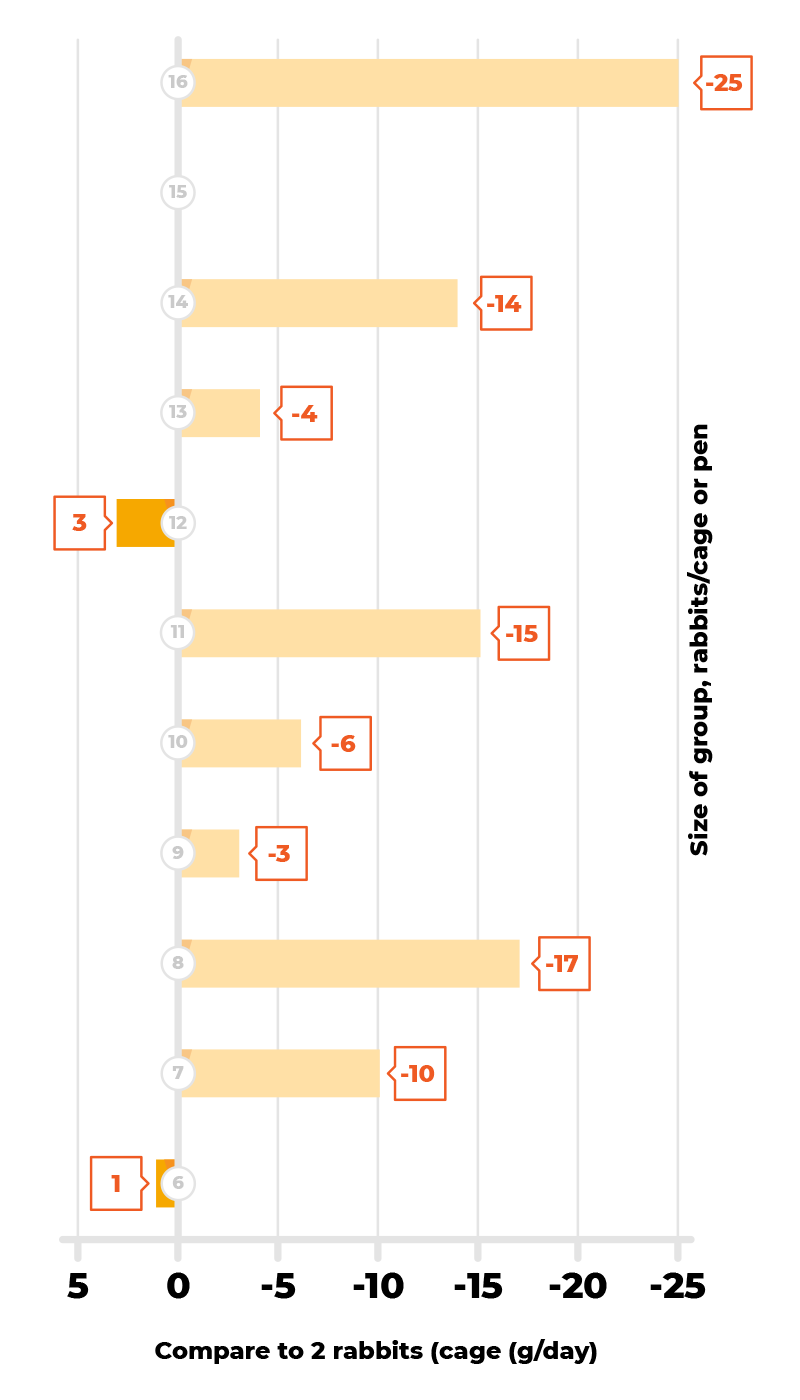
Szendrő et al. (2014) and Krunt et al. (2021) compared the cage (3 rabbits/cage) and pen housing (14 rabbits/pen or 25 rabbits/pen). They observed a significant decrease in feed intake, weight gain and body weight in pen housed rabbits. There was no difference in feed conversion ratio between the two groups and the difference in mortality was not significant.
In the study of Szendrő et al. (2014) no animal with injured ear was found in the cage, while a third of the rabbits in the pen were injured.
Leblatier et al. (2017) established that increasing the size of the pen (group size) had a negative impact on rabbit health. The mortality in pens of 48, 24 and 8 rabbits were 17.7%, 7.3% and 2.3%, respectively. The reason could be mixing of rabbits from different litters, aggressive behaviour and stress.
Maertens and Van Herck (2000) showed a higher mortality rate in larger groups which could be due to increased infectious pressure. In a meta-analysis, Sommerville et al. (2017) found that the mortality of growing rabbits increased with increasing group size. This effect was attenuated when enrichment objects were used.
Maertens and Van Herck (2000) observed that weaned rabbits were particularly sensitive to noise and human appearance.
Animals run into a corner of the pen, climbing on top of each other, trying to escape. This fear reaction decreased with age. Princz et al. (2009) observed, that weight gain in large-group rabbits decreased in the week after weaning, which may be related to the stress described above.
Compared to bicellular cages, growing rabbits in pens spent less time feeding, allo-grooming and more time moving and resting. In larger pens the rabbits spent less time eating, self-grooming and sniffing and more time resting than in small ones.
The corticosterone level was higher in the rabbits housed in pens compared to those in bicellular cages (Trocino et al., 2014). All these results show that animals in larger groups live under greater stress.
Rabbits housed in larger groups moved more and showed more social contacts and especially aggressive behaviour than in small groups (Dal Bosco et al., 2002; Lambertini et al., 2001; Princz et al., 2008a; Sommerville et al., 2017).
This raises the question whether rabbits move more in the group because there is more space, or escape from the aggressive (offensive) acts?
Group size and aggression
Aggressive behaviour started at puberty, and at 11 weeks of age more than 10 percent of the rabbits showed injured ears (Szendrő et al., 2009) (Figure 3).
Incidence of injuries (%) due to aggressive behaviour between 9 and 11 weeks of age (Szendrő et al., 2009)
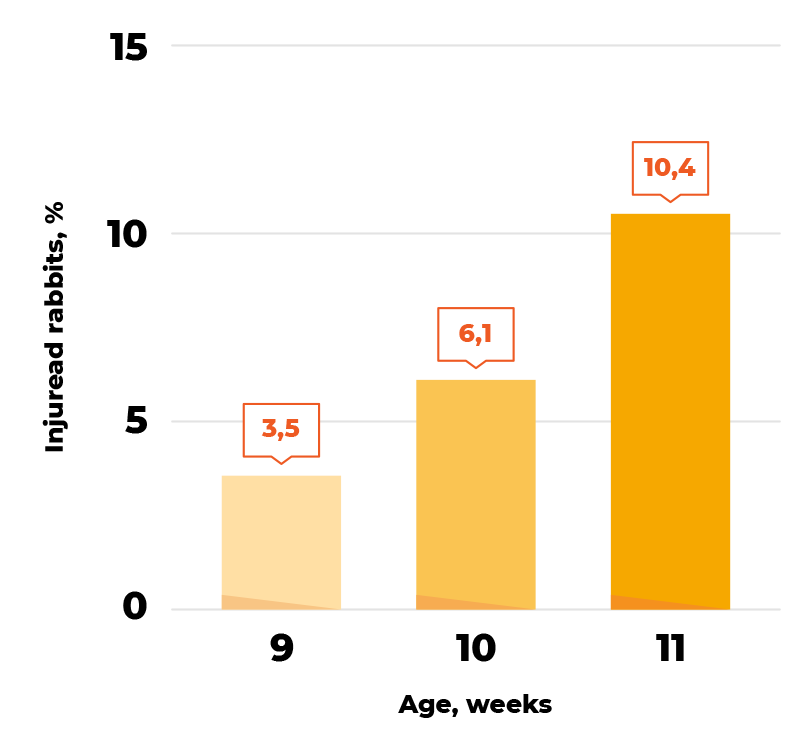
Similar results have been reported by Bigler and Oester (1996) Frequency and severity of injuries of rabbits in a cage or pen increased with increasing group size due to the higher number of fighting (Figure 4).
Rommers and Meijerhof (1998) suggested that fattening should be finished at 80 days of age since between 73 and 80 days of age, the proportion of injured individuals increased from 6–16% to 20–41%.
The possibility of reducing aggression and injuries will be discussed in the part of environmental enrichment.
The incidence and severity of ear injuries depending on the group size (Bigler and Oester, 1996)
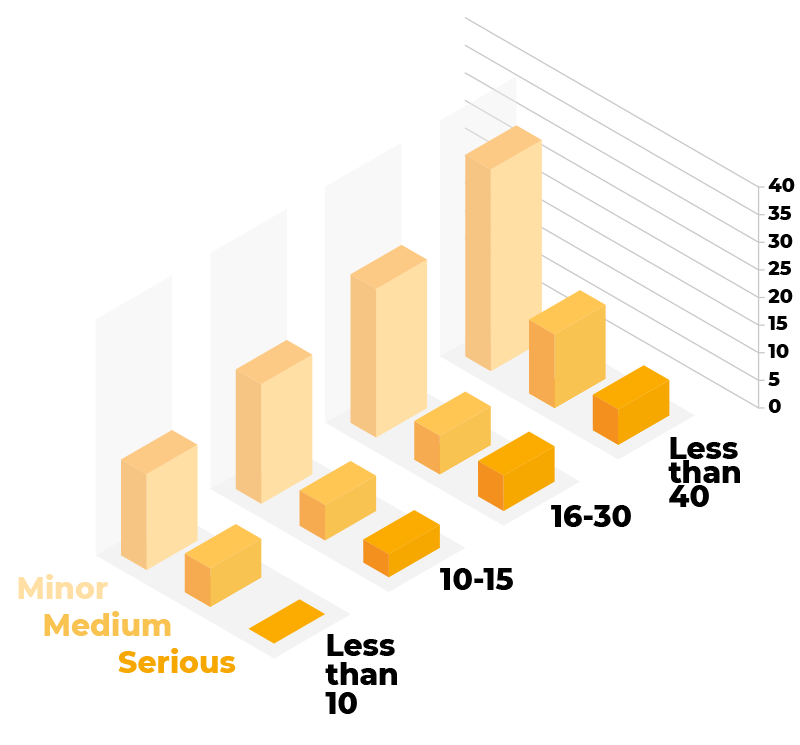
The semi-group system
Within group housing, the “semi-group housing system” represents a special form of group housing, which was also called “park” system. The park system consists of four individual cages for the does and their litter.
The does are housed individually from a few days before parturition till 18th day of lactation. Then the walls between the cages are removed and the does with their litter build a large group where they are kept for 3 more weeks (Maertens et al., 2011; Buijs et al., 2014).
After weaning the pregnant does are moved in a pen-unit, and the kits stay in the large group (Maertens and Buijs, 2013). Several papers have been published on the performance of the does, but only a few of them on the growing rabbits.
After each regrouping, aggressive behaviour and fights occur, and 50-60% of the rabbits show minor or serious injuries. Although this is completely contrary to animal welfare, it is supported by animal welfarists.
Jehl et al. (2003) compared traditional cages (6 rabbits/cage), double height cages with elevated platforms (10 rabbits/cage) and pens (semi-group housing systems; 45 rabbits/pen). The body weight decreased by 130 g in pens and mortality was higher in pens compared to the cages of 6 resp. 10 rabbits (18% vs 4%).
Maertens and Buijs (2013) compared growing rabbits reared in enriched cages with the semi-group system. In the large groups of the semi-group system the body weight at 69 days of age was 5-7% lower than that of those raised in the cages. Mortality was low in all groups. Roy et al. (2017) reported similar results when conventional cages (6 rabbits/cage) and a park system (35 rabbits/pen) were compared.
Body weight decreased in the park, but there was no difference in mortality. Machado et al. (2023) found no negative effect of the housing systems (individual cages and semi-group housing of the does) on growing rabbit’s performance until 56 days of age.
Maertens and Buijs (2013) and Machado et al. (2023) did not publish data on the proportion of injured rabbits, but Trocino et al. (2022) found hardly any injured rabbits (0.2-0.5%) in standard, dual-purpose and enriched cages. In the park (semi-group) system this value was 8.8%.
Presumably, due to the fights, hair cortisol content was also significantly higher in the park than in the other three systems. Hube et al. (2023) found that an increase of does to two or three, there were more injured kits than in the individually housed does.
The European wild rabbits often live in large groups (Di Vincenti and Rehrig, 2016).
Foraging in groups increase in the probability of detecting a predator and reduce the risk related to predation (Villafuerte and Moreno, 1997).
In Australia, where wild rabbits have no enemies (predators), rabbits can live not only in groups, but also alone (Wheeler et al., 1981). The advantage of large groups under natural conditions does not exist on the farm (Szendrő and McNitt, 2012) and the only benefit which remains is the social contact.
However, social contacts in large groups of farmed rabbits bear various risks, such as social stress, aggressive behaviour, higher risk of disease, etc.
Housing 4-5 kits together may be ideal. If only littermates are housed together, group size of 8-10 rabbits can be viable and minor reduction in production is offset by a lower risk of infection.
Growing litter mates in one group to slaughter age is practiced in the so-called dual-purpose cages (Figure 5).
Dual purpose cage. The does give birth in this cage, and at weaning, the does are moved into another cage, and kits are reared in it until slaughter
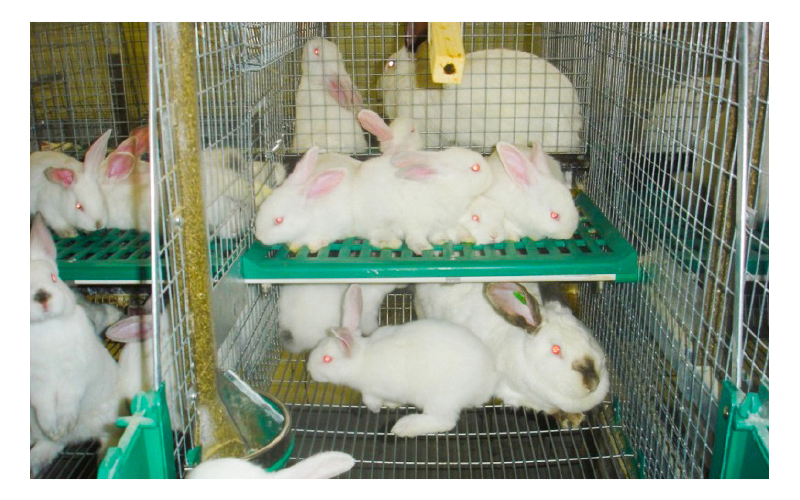
In this system, two buildings are equipped with a cage system which can be used for reproduction and fattening. The does are placed into a cage which is provided with a nest where she stays with her offspring up to weaning. After weaning the doe is moved to cages in the second building and the kits remain in the cage where they were born.
Stocking density
The effect of stocking density on production of growing rabbits is summarized in the review of Szendrő and Dalle Zotte (2011) (Figure 6).
Effect of stocking density (7-29 rabbits/m2) on body weight gain of growing rabbits compared to stocking densities of 16 rabbits/m2 (shown by the line at 0) (Szendrő and Dalle Zotte, 2011)
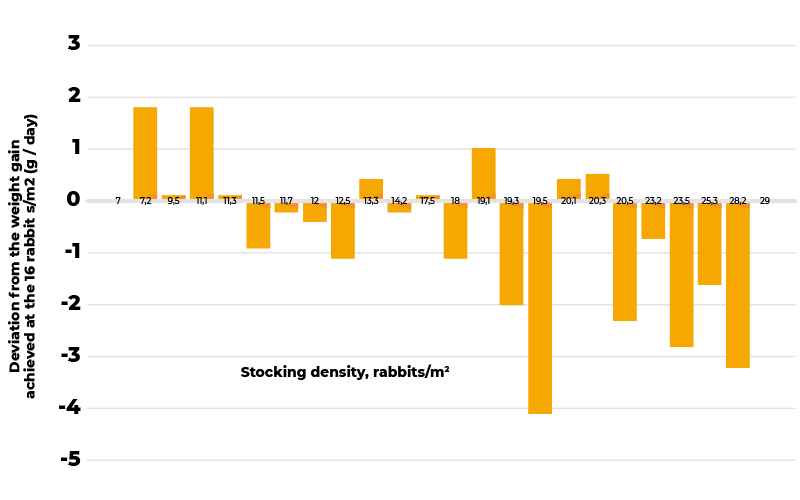
According to Xiccato et al. (2013) stocking densities of 12 or 16 rabbits/m2 did not affect feed intake, weight gain, body weight and feed conversion ratio of growing rabbits.
Similar results were found by Abdel-Hamid (2018) and Omar et al. (2020). Above 16-17 rabbits/m2, feed intake, body weight gain and body weight decreased in the majority of cases. If the stocking density was below 16-17 rabbits/m2, an improvement in production has rarely been observed, i.e., a lower stocking density usually has no economic benefit.
However, contrary to most results, El-Tarabany et al. (2019) reported an increase of feed intake and body weight of growing rabbits and a decrease of the stress level (e.g., serum cortisol) with a reduction of stocking density to less than 16 rabbits/m2.
The effect of stocking density does not really depend on the number of rabbits per m2 of cage floor area, but on live weight per m2 of floor area. Aubret and Duperray (1992) and Maertens and De Groote (1985) have shown that daily weight gain decreased when the stocking density exceeded 46 and 40 kg per m2 (Figure 7).
Body weight gain of growing rabbits (g/day) depending on stocking density and age (live weight) (32-45, 45-55, 55-68 days) (marked with darker columns if there were more than 45 kg rabbit per m2 of floor area) (Aubret and Duparray, 1992)
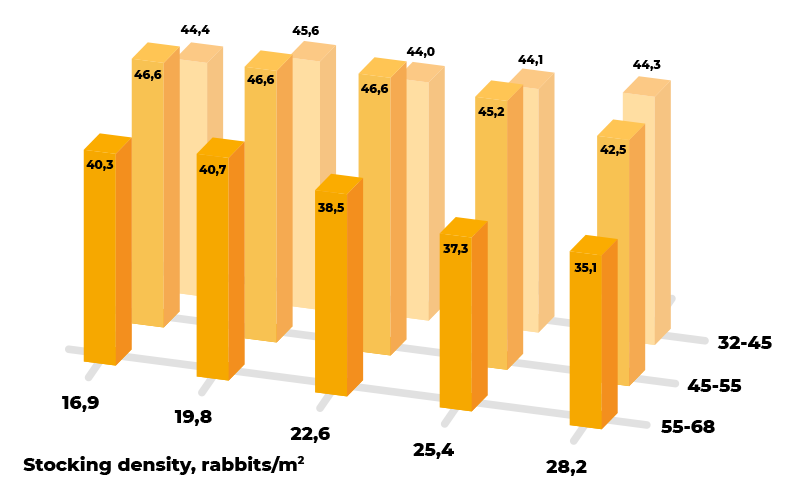
There was no effect of stocking density between 35 and 45 days of age with a stocking density of 30 rabbits/m2. However, weight gain decreased between 45 and 55 days of age with 28.2 rabbits/m2 and between 55 and 62 days with 22.6 rabbits/m2.
Maertens and De Groote (1985) reported slightly different results with rabbits reared until higher age and higher body weight. The negative effect of higher stocking density occurs at the end of the growing period.
The negative effect of stocking density can be avoided by “thinning”.
When 4 or 6 rabbits were placed in the cage after weaning (in which 2 or 3 rabbits were usually reared), and the number or rabbits per cage was reduced to 2 or 3 rabbits in the middle of the growing period, there was no negative effect on production (Matics et al., 2004; Rashwan et al., 2007).
These results demonstrate that thinning could improve utilization of buildings and cages without a decline in production performance. Of course, it should be kept in mind that this procedure requires extra work and can cause stress to the animals.
Stocking density and behaviour
Especially young kits need social contact, because they like huddling and warm each other after leaving the nest box. In a preference test, Matics et al. (2002) examined how many rabbits chose the different sized cages: the smallest (used for two rabbits), the twice, three-, and four-times larger ones.
Kits were weaned at a very young age of 3 weeks. By the first week, the majority of them crowded into the smallest cage. With an average density of 11 rabbits/m2 in all cages, the density was 70 rabbits/m² in the smallest cage (Figure 8).
Rabbit density (rabbits/m2) in cages of different sizes (1x: small and 2x, 3x, 4x larger area) in case of free choice, between 3 and 10 weeks of age (Matics et al., 2002)
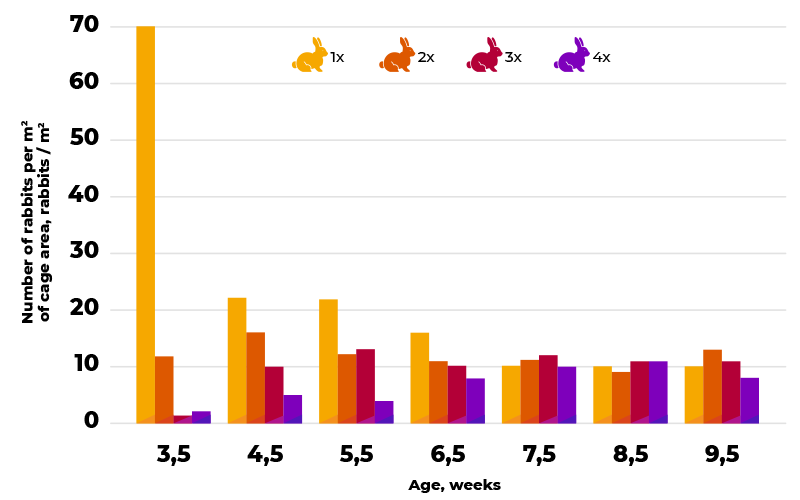
Over the next two weeks, the density in the smallest cage was twice as high as the average and the difference of densities between the cages became equalized at 7 weeks of age.
Comparing stocking densities of 12 and 16 rabbits/m2, Trocino et al. (2004, 2014) did not observe any differences in behavioural patterns of rabbits. Morisse and Mourice (1997) examined the most important behavioural welfare indicators of growing rabbits (resting, eating and drinking, comfort, discovery, social, antagonistic, exercise) at stocking densities of 15.5, 17.8, 20.4 and 23.0 rabbits/m2. 40 kg of liveweight per m2 were found to be ideal.
This corresponds with the results of weight gain shown above. Studies on the relationship between stocking density and aggressive behaviour are not consistent. While Morisse and Maurice (1997) found no difference between groups of different stocking density, Szendrő et al. (2009) recorded more ear injuries in groups of 12 rabbits/m2 than in 16 rabbits/m2. According to Yakubu et al. (2008), increasing the stocking density from 10 and 14.3 rabbits/m2 to 20 and 25 rabbits/m2 led also to increasing bite injuries.
From the production performance, as well as from the observation of the behaviour, it can be stated that 16 rabbits/m2 rabbit which corresponds to 40 kg rabbits/m2 at the weight at slaughter is 2.5-2.7 kg), can be considered as ideal stocking density (EFSA, 2005).
Above this density, production is already deteriorating and behaviour is changing. Benefits for animal welfare from further reducing stocking density (<16 animalsm2; <40 kgm2) in alternative pen housing systems have not been identified (Szendrő and Dalle Zotte, 2011; Xiccato et al., 2013; Trocino et al., 2014).
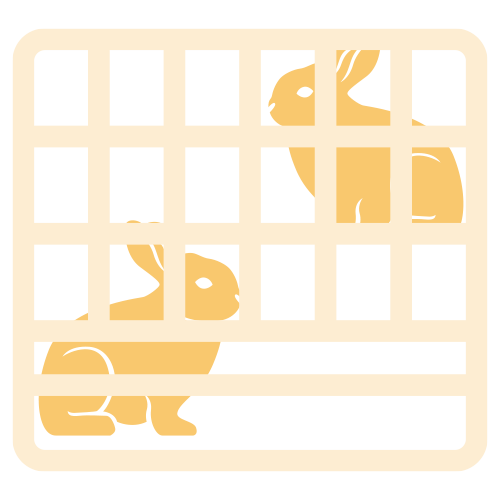
Floor type
The floor is one of the most important elements of the cages, because the rabbits move, stand and rest on it. It is essential that, examined from several aspects, they satisfy the needs of the animals.
Authors have been reporting few differences in weight gain, weight, feed intake, feed conversion ratio and behaviours (resting, moving, eating, drinking etc.) of growing rabbits housed on plastic-net, wire-net or slats compared with the conventional wire-net floor in cages or pens (Petersen et al., 2000; Trocino et al., 2008; Princz et al., 2008b, 2009; Lang, 2009).
Animal welfare organisations raise concern about wire floors in cages and recommend deep litter floor. The preference for different floor types has been established in various choice tests.
In a free-choice experiment, with half of the pen floor of straw deep litter and the other half of wire-mesh 80 to 85 % of the rabbits chose the wire-mesh floor (Figure 9; 10), regardless of the stocking density (8, 12, or 16 rabbits/m2). (Orova et al., 2004).
Choice of growing rabbits between deep litter and wire-mesh floor
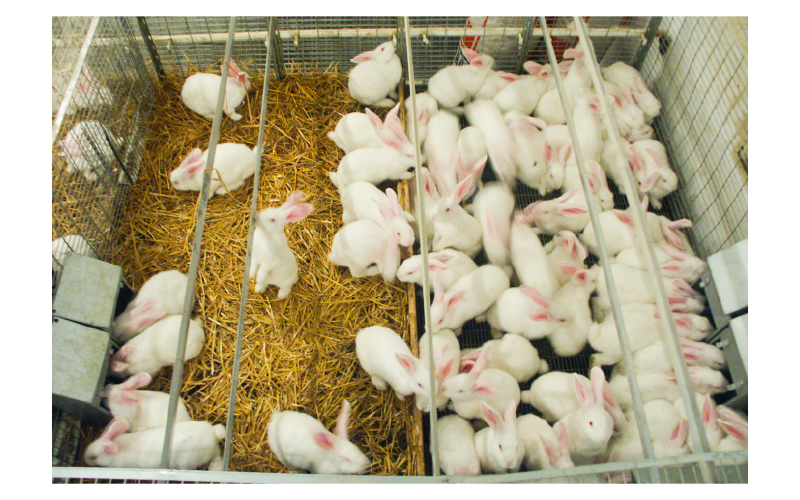
Preference of growing rabbits for straw litter and wire mesh floor, (ratio of rabbits choosing wire mesh floor, %) depending on the stocking density (8, 12 and 16 rabbits/m2) from 5 and 10 weeks of age (Orova et al., 2004)
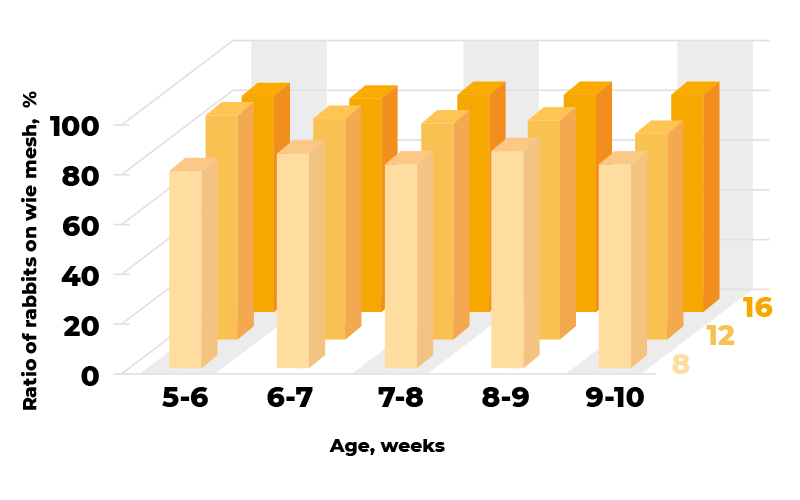
To prevent wet and contaminated litter, fresh straw was scattered every day and the entire litter was replaced once a week. When the new material came in, the rabbits ran on the straw with interest (novelty), but after half an hour, the majority of rabbits returned to the wire-mesh.
The preference for wire mesh led to overcrowding on this part of the pen. With an average stocking density of 16 rabbits/m² of the total pen space, 23-24 rabbits/m2 were observed on the wire floor.
Hence crowding did not reduce the preference for wire net as floor material.
According to Bessei et al. (2002), the choice between deep litter and metal grid depends on temperature. To prove this, a preference test was conducted in which the rabbits could choose between three floor types, deep litter, plastic-mesh and wire-mesh, at three temperatures (10-11 oC, 17-20 ºC and 22-26 ºC (Figure 11).
Choice of growing rabbits between deep litter and wire-mesh floor
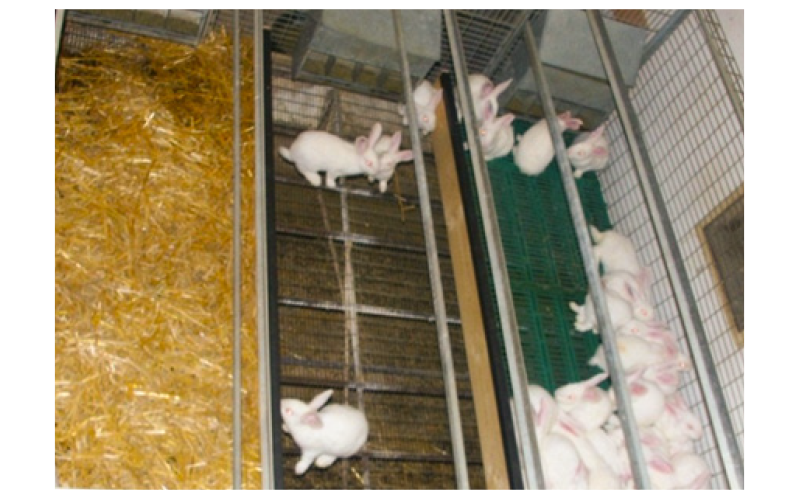
As in the other free choice experiments, the position of the floors was different in each repetition to eliminate random effects (Gerencsér et al., 2014).
Irrespective of temperature, the fewest rabbits (5–14%) were observed on the deep litter. Plastic-mesh floor was generally preferred, but as the temperature increased and age progressed, fewer rabbits chose this floor. Between 5 and 11 weeks of age, the percentage of rabbits choosing the plastic-mesh decreased from 70% to 52% at the low temperature, from 67% to 43% at the intermediate temperatures, and from 59% to 41% at the high temperature.
An inverse trend was observed on the wire-mesh floor in response to temperature and age: At the low, intermediate and high temperature the percentage of rabbits increased from 25 to 38 and 45 % respectively. As age progressed, the proportion of rabbits on the wire-mesh floor increased from 23% to 33%, from 28% to 49% and from 34% to 47% at the low, intermediate and high temperature.
The critical age where the preference for plastic floor switched towards the wire floor was 10 weeks at the intermediate and 7 weeks at the high temperature. The question arises, why rabbits choose a floor like wire netting that looks uncomfortable. The causal factor is obviously the problem of heat dissipation.
The dense fur coat and lacking few sweat glands hamper dissipation of metabolic heat dissipation. Hence, it is more advantageous to choose a floor with good thermal conductivity (wire-mesh) than a seemingly comfortable deep litter, or even plastic-mesh floor (Bessei et al., 2002).
Under farmed conditions, rabbits are almost exclusively housed on wire-mesh flooring for hygienic reasons. Straw as litter is perceived as feed and consumed. Litter material is usually contaminated with urine and feces and represent a high risk for gastrointestinal diseases, enteritis or coccidiosis. Wooden floor is also undesirable because the urine and manure could accumulate on it.
Gnawing at this dirty material has negative implications for hygiene and health. There exists a close correlation between the perforation of the floor and dirtiness or injuries. A floor with only 10 % perforation on an elevated platform led to a high percentage of dirty animals (99 %) and to a high frequency of leg lesions (25 %) (Masthoff et al., 2017a). It can be concluded that floor design without or with low degree of perforation is contrary to animal welfare.
Ribikauskas et al. (2010) observed the behaviour of growing rabbits on deep litter (15 rabbits/pen) and on wire net (6 rabbits/cage). Rabbits kept on deep litter spent less time resting and grooming and more time eating compared with those kept in the wire mesh cages. However, floor type was confounded with group size, which may also have influenced the behaviour.
Kustos et al. (2003) covered a wire floor with straw as litter at different age periods: 5 to 11, 5 to 9 and 5 to 7 weeks of age. In one group, the rabbits stayed on a wire-mesh floor from 5 to 11 weeks of age.
The rabbits on the deep litter consumed less pelleted feed and achieved lower body weight gain than the rabbits kept on wire floor only. Reduction of the intake of pellets in response to litter material was also reported by Jekkel et al. (2007). The rabbits began to consume straw as litter as soon it was offered on the wire floor and two weeks after, the frequency of consumption of straw was higher than that of pelleted feed.
Reduction of pelleted feed in response of availability of litter has also been reported by Dal Bosco et al. (2000;2002), Maertens and Van Oeckel (2001) and Lambertini et al. (2001).
In addition, rabbits kept on a straw-bedded wire floor showed more fearful behaviours in the open field test and more fear towards man at the tonic immobility test (Trocino et al., 2008). Windschnurer et al. (2019) compared pens with slatted plastic-floor and concrete floor with straw litter on it. As expected, litter consumption had a negative effect on weight gain, however it is surprising that parasitic load and mortality was not higher in rabbits kept on straw (Table 1).
Feed intake, body weight gain and body weight of rabbits depending on the age when straw litter was placed on the wire mesh floor (Kustos et al., 2003)
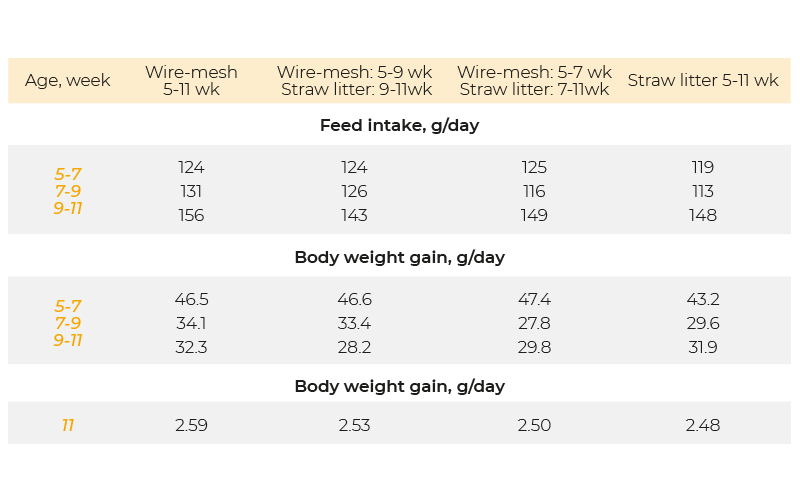
It can be concluded that housing rabbits on deep litter does not meet animal welfare expectations. Given the free choice between litter and perforated floors, rabbits prefer to stay on a wire-mesh or plastic-mesh floor. At the same time, keeping rabbits on litter has an negative impact on weight gain and mortality.
Nevertheless, there are markets that pay a higher price for meat originated from rabbits kept on deep litter.
Matics et al. (2003) studied the choice of growing rabbits of four types of floor: solid floor, plastic-mesh, plastic-slat, wire-mesh. They were allowed to move freely among cages through swinging doors.
At all ages the rabbits avoided the solid floor which was wet and contaminated with feces and urine (Figure 12). The plastic-mesh floor was generally preferred, but fewer rabbits stayed on it with advancing age. Although initially rabbits avoided, the plastic-slats were accepted from the age of five weeks.
The low acceptance of plastic slats was probably due to the gap in between the slats where the young kits slipped in with their legs. The same was observed by Trocino et al. (2014). The choice of wire-mesh floor also increased steadily with age. By 9-10 weeks of age there were no significant differences between plastic-mesh, plastic-slats and wire-mesh floor (Figure 12).
Free choice of growing rabbits among solid floor (SF), wire-mesh (WM), plastic-slat (PS) and plastic-slat (PS) floor (Matics et al., 2003)
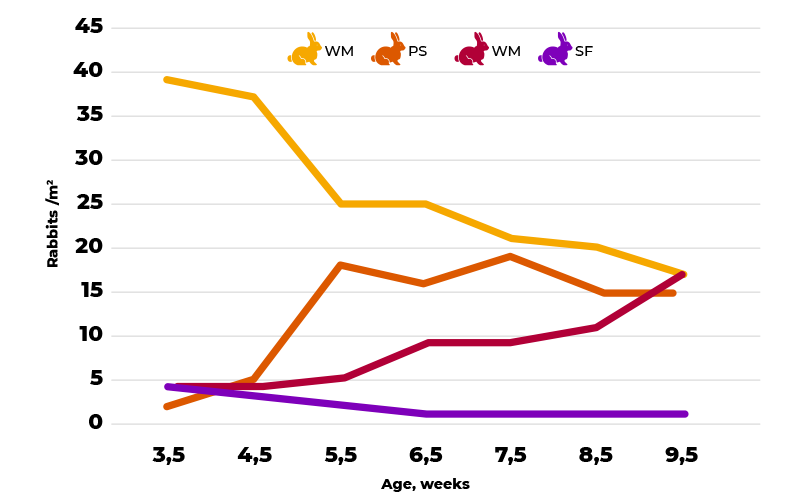
Princz et al. (2008) tested the preference between plastic-mesh and wire-mesh floor at stocking densities of 16 and 12 rabbits/m2. A decrease in the choice of plastic-mesh floor and an increasing preference for the wire-mesh floor was observed in older ages. However, the choice was not completely equalized.
There was a greater difference in preference between the two floors in groups with lower density. This result proves that the greater need for space associated with age and body weight can also contribute to the choice between floors.
The frequencies of behaviour patterns (rest, exercise, eating, drinking, etc.) were also examined, and no differences were found between the two floors, so resting or locomotor activity was not affected by the floor.
Matics et al., 2019 tested a pen with plastic-mesh floor and plastic-mesh elevated platform as recommended by an animal welfare organisation group was tested (Figure 13).
A pen for growing rabbits recommended by an animal welfare organization

It has been assumed, that rabbits feel better in larger pens (65 rabbits) with raised platforms where they have the opportunity to move up and down. Plastic-mesh floor was considered more comfortable than wire-mesh.
This system was compared with smaller cages where 8 siblings were kept on wire-mesh floors with plastic mesh resting plates and plastic-mesh elevated platform (Figure 14). The same stocking density was used in both systems.
Cage with wire-mesh floor, resting plate and plastic-mesh elevated platform

In the large pen, the live weight was lower and feed conversion rate was worse than in the cages. However, the largest difference was found in mortality. Six times more rabbits died in the large pen than in the cage (Table 2).
Productive performance of growing rabbits housed in large pens or cages (Gerencsér et al., 2012)

This was due in part to the fact that in a larger group, a sick rabbit was able to infect more companions than in the smaller group. Another reason was that, at the beginning of the experiment, the pen was clean.
As most of the rabbits chose the part under the elevated platforms for defecation and urination, the plastic-mesh floor became soiled through manure (Figure 15) which increases the risk of spreading diseases throughout the group.
Plastic floor contaminated with manure
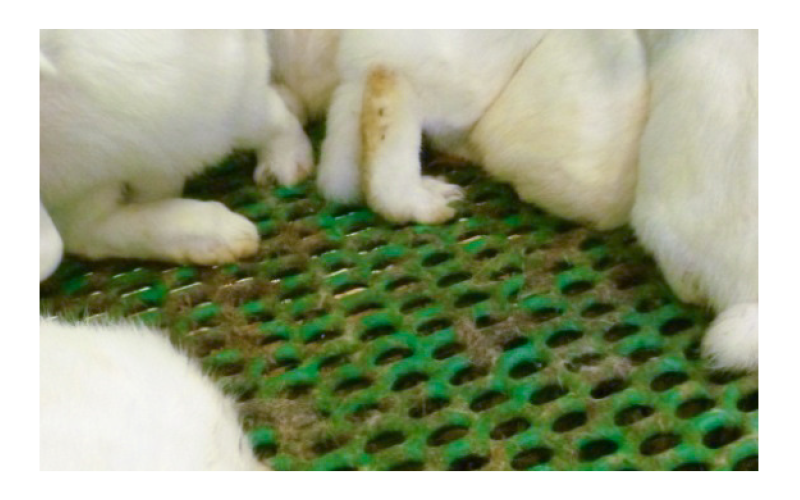
Although the plastic-mesh is more comfortable than the wire-mesh, the thicker the part between the holes, the more manure can accumulate on it, and a worsened hygienic condition occurs.
Therefore, it is recommended to use plastic-mesh only for the elevated platform.
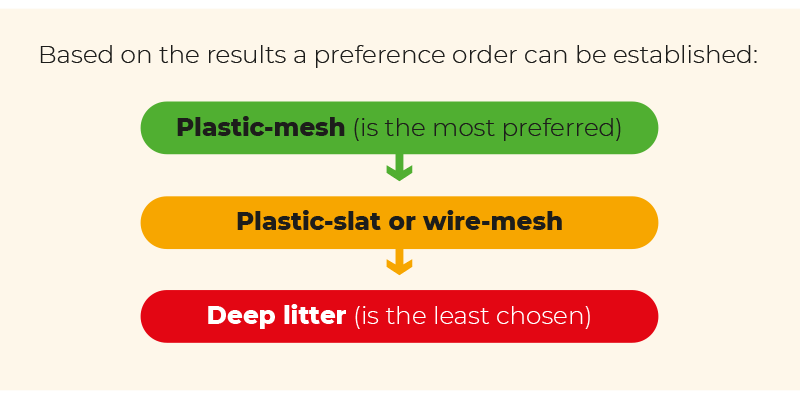
Perforated floor types: Influence on hygienic conditions leg problems
According to the German animal welfare requirements for rabbit housing a maximum slot width of 11 mm and a degree of perforation on the elevated platform of 15% are required.
Masthoff and Hoy (2019) compared the recommended floor type (A: slat and slot widths: 10 and 10 mm, perforation: 15%) with three alternative floors, and examined the frequencies of polluted and injured animals.
By designing different slat and slot widths (B: 10 and 10 mm, C: 12 and 12 mm, D: 5 and 13 mm, respectively), and the percentage of perforation on the floor and on the elevated platform was 50, 50 and 75%, respectively.
The frequency of soiled rabbits was 99.8, 76.8, 50.3 and 15.8%, for A, B, C and D, respectively, while the frequency of wounded rabbits was 25.3, 7.2, 2.4 and 0.7%, respectively.
Rauterberg et al. (2019) designed cages with 15% perforation on the elevated platform taking the German regulations into account. The floor was made of 11 mm slats and 11 mm gaps or 11 mm rods with 11 mm spacing.
In the control group, the rabbits were housed in conventional wire-mesh cages. They examined the soiling scores of the floor and the feet. Serious hygienic problems occurred with the low level of perforation on the elevated platform. According to the results, the proposed floor type is unsuitable for keeping rabbits.
The highest level of cleanness and the lowest frequency of injured rabbits was found on a plastic floor with 5 mm slat width and 13 mm slot width, with the perforation of 75%.
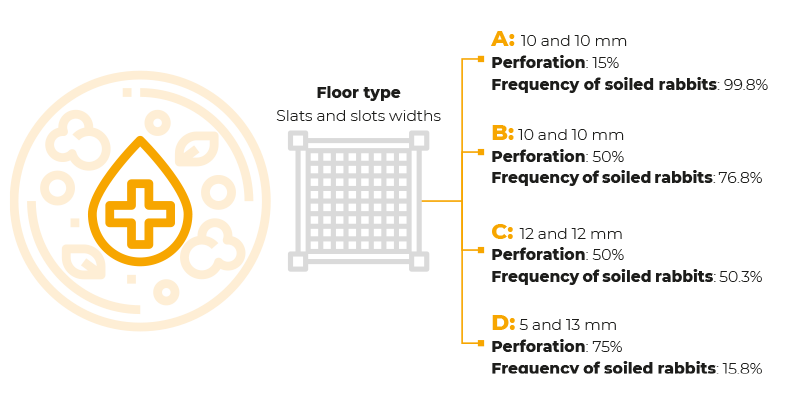
Height of cage
According to the study in Spain and Portugal, 41 % of the farms had a cage height of at least 38 cm, 44 % of the farms had a cage height between 32 and 34 cm, while the remaining 15 % had a cage height was less than 32 cm (Botelho et al., 2020). For welfare reasons it is expected that rabbits should have sufficient vertical space to take an upright position on the hindlegs.
This behaviour can be observed in European wild rabbit (Monclús and Rödel, 2008). It should be noted, that this posture is mainly used to detect predators (Szendrő and Dalle Zotte, 2011). Since there are no predators in the rabbit houses, this behaviour is very rare, not even accounting for 1 % of the time budget (Martrenchar et al. 2001; Finzi, 2005).
Jensen (2002) concluded that if the environment does not elicit certain behaviour (e.g. the upright position) than it is not likely that the lack of this behaviour represents a welfare problem.
In a preference test, growing rabbits could choose between cages of 20, 30 and 40 cm height or open top (Figure 16; Princz et al., 2008b). The rabbits visited the 20, 30, and 40 cm high cages at a similar rate of 28–29% and clearly avoided the open top cage (16%).
The incidence of aggressive behaviour the production in pens with different height was studied by Princz et al. (2008b). Growing rabbits from 5 to 11 weeks of age were housed in pens of 20, 30, and 40 cm high and open top.
Preference of growing rabbits for of different cage height and open top (Princz et al., 2008b)
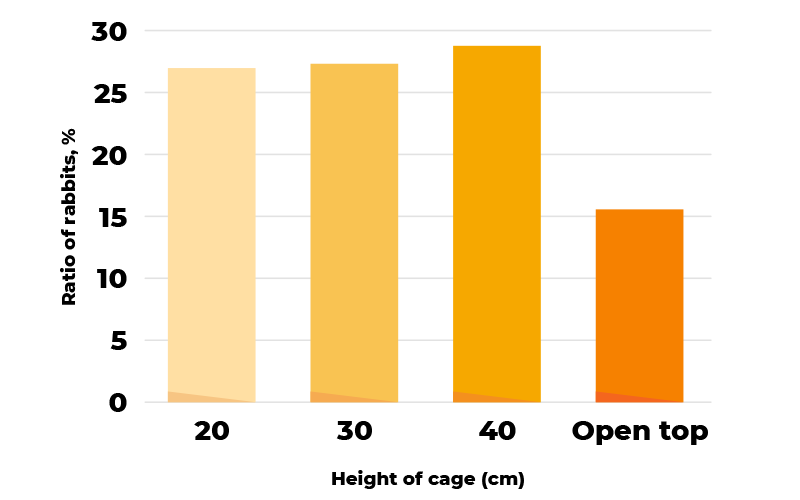
There was no influence of pen height on performance criteria. But rabbits at 20 cm cage height had a high incidence of ear bites. This effect might have been caused by stress induced through hampered travel between feeders and drinkers.
Based on the results of the preference test, production and aggressive behaviour, it can be concluded that the most common 30-35 cm high cage in the practice fully meets the needs of rabbits. From an animal welfare point of view, the use of open top cages or pens recommended by some animal welfare organizations is debatable because rabbits prefer roofed ones.
The question arises why rabbits avoid the open top cage and even prefer a very low, 20 cm high cage. Being a prey animal, wild rabbits feel safe in narrow warren (about 20 cm) or in bushes and are usually reluctant to stay in the open field (Villafuerte and Moreno, 1997; Lombardini et al., 2003).
This behaviour may have been preserved during domestication. Open top cages may be perceived as an open field and elicit fear and avoidance in domesticated rabbits.
In the case of the deep litter platform, Rabbits were mostly were observed underneath the deep litter platform while they preferred to stay on top of the wire platform.
The avoidance of the deep litter platform may be explained by problems of heat dissipation on the straw bedding and the preference for hidden places. The avoidance of the area underneath the wire platform may be caused by prevention of urine excreted by pen mates on the platform. Installing a manure pan under the wire-mesh platform improved the acceptance of this area.
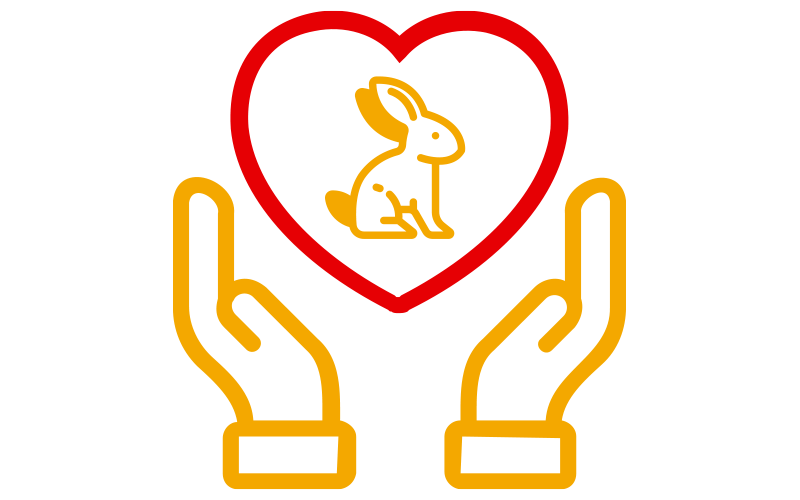
CONCLUSIONS
The opinion, that domestic rabbits should be kept in large groups as observed in wild rabbits is erroneous. The primary motivation for wild rabbits to live in large groups is the risk of predation, higher chance for surviving (looking for predators and escape in time).
There are no predators in the rabbit house. So, housing domestic rabbits in large groups has mainly disadvantages, such as aggression, injuries, stress, infection risk, higher mortality and poor production and reproduction.
All these criteria are indicators of poor welfare. The dual-purpose cages, in which all rabbits of the same litter (full-sibs) stay together after weaning, until slaughtering is the best for the animals.
Although animal welfare organisations recommend open-top cages/pens, rabbits rarely choose this condition because they feel safer under a roof.
Stocking density of more than 16 rabbits/m2 or 40 kg rabbits/m2 is not recommended from either production or animal welfare point of view. At the same time, lower density does not improve the welfare.
There are several disadvantages housing rabbits on deep litter. Eating litter increase the risk of infectious diseases. The rabbits feel uncomfortable on litter in a warm ambient temperature, because they are not able to dissipate the metabolic heat load.
Adequate flooring should be preferred by the rabbits, with materials which are durable, easy to clean and disinfect. Both plastic-mesh and wire-mesh floor are recommended. The combination of wire-mesh floor and plastic-mesh elevated platform is considered the optimum solution.
References
List of references will be shown in Part 2 of this article.Подпишитесь на нашу рассылку
И узнайте обо всех последних новостях индустрии.



